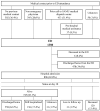EPICANCER-Cancer Patients Presenting to the Emergency Departments in France: A Prospective Nationwide Study
- PMID: 32429507
- PMCID: PMC7291158
- DOI: 10.3390/jcm9051505
EPICANCER-Cancer Patients Presenting to the Emergency Departments in France: A Prospective Nationwide Study
Abstract
Background: We aimed to estimate the prevalence of cancer patients who presented to Emergency Departments (EDs), report their chief complaint and identify the predictors of 30-day all-cause mortality.
Patients and methods: we undertook a prospective, cross-sectional study during three consecutive days in 138 EDs and performed a logistic regression to identify the predictors of 30-day mortality in hospitalized patients.
Results: A total of 1380 cancer patients were included. The prevalence of cancer patients among ED patients was 2.8%. The most frequent reasons patients sought ED care were fatigue (16.6%), dyspnea (16.3%), gastro-intestinal disorders (15.1%), trauma (13.0%), fever (12.5%) and neurological disorders (12.5%). Patients were admitted to the hospital in 64.9% of cases, of which 13.4% died at day 30. Variables independently associated with a higher mortality at day 30 were male gender (Odds Ratio (OR), 1.63; 95% CI, 1.04-2.56), fatigue (OR, 1.65; 95% CI, 1.01-2.67), poor performance status (OR, 3.00; 95% CI, 1.87-4.80), solid malignancy (OR, 3.05; 95% CI, 1.26-7.40), uncontrolled malignancy (OR, 2.27; 95% CI, 1.36-3.80), ED attendance for a neurological disorder (OR, 2.38; 95% CI, 1.36-4.19), high shock-index (OR, 1.80; 95% CI, 1.03-3.13) and oxygen therapy (OR, 2.68; 95% CI, 1.68-4.29).
Conclusion: Cancer patients showed heterogeneity among their reasons for ED attendance and a high need for hospitalization and case fatality. Malignancy and general health status played a major role in the patient outcomes. This study suggests that the emergency care of cancer patients may be complex. Thus, studies to assess the impact of a dedicated oncology curriculum for ED physicians are warranted.
Keywords: cancer; emergency department; epidemiology.
Conflict of interest statement
All authors declare no potential conflict of interest related to the study.
Figures




References
-
- Howlader N., Noone A.M., Krapcho M., Miller D., Bishop K., Kosary C.L., Yu M., Ruhl J., Tatalovich Z., Mariotto A., et al. SEER Cancer Statistics Review, 1975–2014. National Cancer Institute; Bethesda, MD, USA: 2014.
-
- Defossez G., Le Guyader-Peyrou S., Uhry Z., Grosclaude P., Colonna M., Dantony E., Delafosse P., Molinié F., Woronoff A.S., Bouvier A.M., et al. Etude à Partir des Registres des Cancers du Réseau Francim. Résultats Préliminaires. Synthèse. Saint-Maurice; Santé Publique, France: 2019. Estimations nationales de l’incidence et de la mortalité par cancer en France métropolitaine entre 1990 et 2018.
LinkOut - more resources
Full Text Sources

